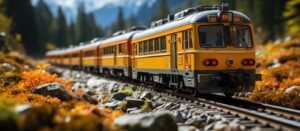Boxcars are a cornerstone of rail freight. They are known for their enclosed design and versatility. As you know all boxcars appeared in the 1830s. Boxcἀrs quickly became essential in shipping various goods. But historically, boxcars handled most non-bulk freight, which included automobiles. Their role evolved with specialized rail cars in the 1960s. Besides this, they remain vital for transporting diverse products.
Today, boxcἀrs continue to play an important role in freight transport. Indeed, their enduring design and functionality make them a staple in rail logistics. S—their history reflects their importance in transportation.
Types of Boxcars
Boxcars come in different sizes and configurations. The 50-foot plain boxcar is common for transporting items like paper and beverages.
- It typically offers a capacity ranging from 4,950 to 7,300 cubic feet.
- The 60-foot plain boxcar handles larger items such as coil products and lumber.
- It provides a cubic capacity of 5,830 to 7,633 cubic feet. This site is well-suited for a variety of bulk goods.
- Insulated and refrigerated boxcἀrs made to specialized needs.
- Insulated boxcἀrs are used for temperature-sensitive products.
- Refrigerated boxcἀrs, or reefers, maintain optimal conditions for perishable goods.
What are The Design and Features Of Boxcars?
You know that Boxcars have a distinctive rectangular shape. Their enclosed structure protects cargo from the elements. Its side sliding or plug doors allow for flexible loading and unloading.
The interior dimensions vary, but boxcars typically range from 50 to 60 feet in length. The minimum width is around 9 feet. These dimensions ensure ample space for various types of freight.
Door types include single or double sliding and plug doors. But its sliding doors are easy to open but may not seal as well. Plug doors provide a tighter seal, which enhances protection for the cargo.
Uses and Applications
It is important to know about the use and its applications. Boxcars are versatile and can transport many types of goods. You can use it for items that require protection from weather. Commonly shipped goods include forest products, paper, and food items.
The ability to insulate or refrigerate boxcars adds to their versatility. Insulated boxcἀrs are used for temperature-sensitive goods. Refrigerated boxcἀrs, or reefers, are essential for transporting perishable items like fresh produce.

So—Boxcars can handle palletized goods and bulk materials. This flexibility makes them suitable for various industries. Their continued use underscores their importance in rail transport.
Loading and Unloading Processes
Originally, boxcars were loaded and unloaded by hand. This manual process was labor-intensive and time-consuming. Modern techniques have greatly improved efficiency.
Today, forklifts and mechanical devices are commonly used. These tools speed up the loading and unloading process. They also enhance safety and reduce labor requirements.
Boxcars typically have side doors for access. Products are loaded and unloaded through these doors. This design facilitates easier handling of goods.
Evolution and Modern Developments
Boxcars have evolved significantly since their inception. Early models were made of wood but were later replaced by steel. Its steel construction improved durability and fire resistance.
In the 1960s, boxcἀrs were gradually replaced by specialized rail cars. These new designs are better suited to specific types of freight. However, boxcἀrs continue to be a reliable choice for various transport needs.
Modern boxcars include high cubic capacity versions. These hicube boxcἀrs are taller to accommodate larger loads. Their design reflects ongoing advancements in rail freight technology.
Fun Facts and Trivia
Boxcars were originally constructed from wood. This material was sturdy but prone to fire. Steel boxcἀrs eventually replaced wood models for better safety and longevity.
Boxcars were once used to transport automobiles. This changed with the advent of autoracks, which are more efficient. Boxcἀrs also previously handled bulk commodities like coal.
Besides their age, boxcars remain a symbol of rail transport. Their design and functionality have made them iconic. They continue to be a vital part of freight logistics.
Wrap Up
Boxcars are a key element in the history of rail transport. Their design has evolved, but their importance remains unchanged. Their early use of modern applications and boxcἀrs continues to serve various needs.
If you are understanding the different types and features of boxcars highlights their versatility. Their continued use and adaptation reflect their enduring relevance. Boxcἀrs will likely remain an important part of freight transportation for years to come.



